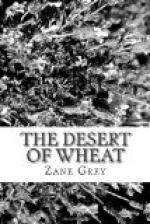“Well, if it should,” she replied, archly, “just consider how I might surprise him with my knowledge of wheat.... Indeed, Mr. Dorn, I am interested. I’ve never been in the Bend before—in your desert of wheat. I never before felt the greatness of loving the soil—or caring for it—of growing things from seed. Yet the Bible teaches that, and I read my Bible. Please tell us. The more you say the more I’ll like it.”
Dorn was not proof against this eloquence. And he quoted two of his authorities, Heald and Woolman, of the State Agricultural Experiment Station, where he had studied for two years.
“Bunt, or stinking smut, is caused by two different species of microscopic fungi which live as parasites in the wheat plant. Both are essentially similar in their effects and their life-history. Tilletia tritici, or the rough-spored variety, is the common stinking smut of the Pacific regions, while Tilletia foetans, or the smooth-spored species, is the one generally found in the eastern United States.
“The smut ‘berries,’ or ‘balls,’ from an infected head contain millions of minute bodies, the spores or ‘seeds’ of the smut fungus. These reproduce the smut in somewhat the same way that a true seed develops into a new plant. A single smut ball of average size contains a sufficient number of spores to give one for each grain of wheat in five or six bushels. It takes eight smut spores to equal the diameter of a human hair. Normal wheat grains from an infected field may have so many spores lodged on their surface as to give them a dark color, but other grains which show no difference in color to the naked eye may still contain a sufficient number of spores to produce a smutty crop if seed treatment is not practised.
“When living smut spores are introduced into the soil with the seed wheat, or exist in the soil in which smut-free wheat is sown, a certain percentage of the wheat plants are likely to become infected. The smut spore germinates and produces first a stage of the smut plant in the soil. This first stage never infects a young seedling direct, but gives rise to secondary spores, or sporida, from which infection threads may arise and penetrate the shoot of a young seedling and reach the growing point. Here the fungus threads keep pace with the growth of the plant and reach maturity at or slightly before harvest-time.
“Since this disease is caused by an internal parasite, it is natural to expect certain responses to its presence. It should be noted first that the smut fungus is living at the expense of its host plant, the wheat, and its effect on the host may be summarized as follows: The consumption of food, the destruction of food in the sporulating process, and the stimulating or retarding effect on normal physiological processes.
“Badly smutted plants remain in many cases under-size and produce fewer and smaller heads. In the Fife and Bluestem varieties the infected heads previous to maturity exhibit a darker green color, and remain green longer than the normal heads. In some varieties the infected heads stand erect, when normal ones begin to droop as a result of the increasing weight of the ripening grain.




